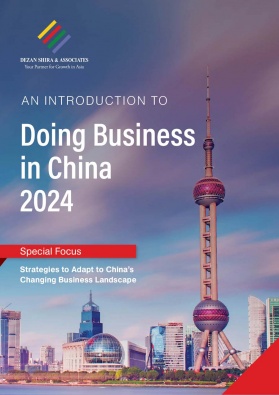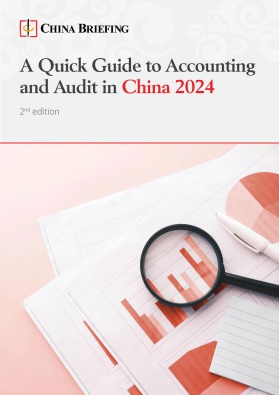China Sets 2024 GDP Growth Target at “Around 5%”: Key Highlights from the Two Sessions
China’s Premier Li Qiang has delivered the highly-anticipated 2024 Government Work Report. This report is the most important annual policy document, setting the key economic and social development tasks for the coming year. In addition to setting the closely watched annual GDP growth target, the 2024 Government Work Report announced the launch of various fiscal policies, such as the issuance of new ultra-long-term special treasury bonds, and proposed measures to attract foreign investment, expand consumption, and improve green development.
On Tuesday, March 5, 2024, the National People’s Congress (NPC), China’s legislature, convened for its opening meeting of the annual Two Sessions. In the meeting, Premier Li Qiang delivered the 2024 Government Work Report (2024 GWR) on behalf of the State Council, which sets a vast range of economic and development tasks for the country to pursue over the coming year. It includes the 2024 GDP growth target and outlines how China plans to achieve its economic goals.
In this article, we look at the key points from China’s 2024 GWR, including the 5 percent GDP growth target, preferential tax policies, and industry priorities, as well as measures to boost consumption, attract foreign investment, maneuver China’s green transition, and mitigate financial risks.
Highlights from the 2024 Government Work Report
- GDP growth rate set at around 5 percent.
- Urban unemployment rate to be kept around 5.5 percent.
- Consumer prices increase to be kept at around 3 percent.
- Current tax and fee incentives will be continued or optimized.
- The deficit-to-GDP ratio is to be kept at 3 percent; deficit of RMB 4.06 trillion (US$563.94 billion).
- Ultra-long-term special government bonds to be issued over several years; RMB 1 trillion (US$138.9 billion) allocated for 2024.
- Local government special purpose bonds quota set at RMB 3.9 trillion (US$541.72 billion).
- Non-economic policies are to be considered when assessing the consistency of macro-policy orientation.
- All restrictions on foreign investment access in the manufacturing sector are to be lifted.
2024 GDP target set at “around 5 percent”
In the readout of the 2024 GWR, the government announced a GDP growth target of “around 5 percent” for 2024, consistent with the target set in 2023.
This target exceeds the expectations of some international institutions. The IMF predicts China’s GDP to grow at 4.6 percent year-on-year in 2024, while JPMorgan predicts a 4.9 percent increase. This demonstrates that the country’s policymakers remain confident in the country’s economic prospects.
Nevertheless, this growth target may be harder to reach in 2024 than in 2023. The relatively strong performance of the Chinese economy in 2023 will create a high base effect, which means the economy will need to maintain its upward trajectory if it is to maintain a similar growth rate as in 2023. By contrast, GDP growth in 2022 slowed to just 3 percent year-on-year, which made hitting the 5.2 percent growth rate in 2023 considerably more likely.
Given this, more direct efforts and policy measures may be needed to stimulate the economy throughout the year. The 2024 GWR indicates China will continue to implement a proactive fiscal policy and a prudent monetary policy, which might be too modest to achieve the ambitious 5 percent growth target.
On the one hand, in the 2024 GWR, the central government urges local governments and departments to introduce policies conducive to stabilizing expectations, promoting growth, and ensuring employment stability, while requesting them to exercise caution when implementing measures that may have a discouraging effect. Careful deployment of fiscal funds and supportive policies in key areas could help to boost the Chinese economy in 2024.
Proactive fiscal policies, but austerity lies ahead
The 2024 GWR calls for “appropriately strengthening” proactive fiscal policies to support the economy in the coming year. As such, the general public budget expenditure will be increased by RMB 1.1 trillion (US$152.79 billion) from the previous year to RMB 28.5 trillion (US$3.96 trillion). The annual quota for local government special purpose bonds (SPBs) will also be increased by RMB 100 billion (US$13.89 billion) from 2023 to RMB 3.9 trillion (US$541.72 billion). SPBs are one of the central government’s key tools for transferring funds to local governments to fund infrastructure projects and stimulate local economies. A further increase in the annual quota signals ambitions to grow the economy, which aligns with the annual GDP growth target.
In addition to the SPBs, the 2024 GWR announced that the government will begin to issue “ultra-long term” special treasury bonds (STBs) for several years, beginning this year. These STBs will be allocated specifically for the implementation of “major national strategies and security capacity building in key areas”. The government will issue RMB 1 trillion (US$138.9 billion) in STBs in 2024.
The 2024 GWR also vows to implement various tax and fee reduction policies to support technological innovation and manufacturing, without specifying which policies will be implemented.
Although the 2024 GWR offers a variety of tools to increase spending, it also warns local governments that they must get used to “living frugally”, manage their budgets carefully, and efficiently deploy financial resources. Provincial governments are encouraged to allocate financial resources to grassroots levels and ensure the “three guarantees” (basic livelihoods, wages, and operating expenses).
The central government has previously warned officials that budgets would be tight in the coming year, as the country faces a range of economic headwinds and local governments grapple with scarcer funding channels and built-up debt.
However, the 2024 GWR also offers some consolation, stating that the central government will increase the intensity of balanced transfer payments to local areas and appropriately prioritize disadvantaged regions.
Finally, the 2024 GWR announced that the central government will increase the per capita financial subsidy standard for resident medical insurance by RMB 30 (US$4.17) and increase the monthly minimum basic pension for urban and rural residents by RMB 20 (US$2.78).
More consistency in macro policy implementation
The 2024 GWR emphasizes stability and predictability of the policy environment, with non-economic policies also to be included in the assessment of the consistency of macro-policy orientation.
Background
The National Development and Reform Commission (NDRC) has launched a policy review mechanism to ensure economic policies are consistent and pro-growth since 2022. Then in December 2023, the Central Economic Work Conference proposed to expand the review mechanism to cover non-economic policies. The NDRC is still working on the specific methods of taking non-economic policies into consistency assessment but promises to provide details as soon as possible.
All regions and departments must carefully listen to the opinions of various stakeholders when formulating policies. Enterprise-related policies must be fully communicated with the market and the concerns of enterprises should be properly addressed.
Meanwhile, the 2024 GWR calls for better coordination and interaction between different policies during their implementation to improve their combined effect and prevent the neglect of certain policies.
If done right, the expanded policy review mechanism will help to address issues surrounding policy inconsistency and uncertainty, which are believed to be partly to blame for the increasing costs and profit decline faced by businesses in 2023.
Modest directives to expand domestic consumption
Boosting domestic consumption has been a key concern for the government since the start of the pandemic. Although consumption experienced a major rebound in 2023 following the lifting of COVID-19 restrictions, overall recovery has been uneven. Retail sales of consumer goods grew by a healthy 7.2 percent from 2022. However, this increase can be partly attributed to the low base effect from 2022, when consumption plummeted due to COVID-19 restrictions.
Meanwhile, the Consumer Price Index (CPI) rose by just 0.2 percent year-on-year, and imports fell by 0.3 percent year-on-year due to weak domestic demand.
To address these issues, the 2024 GWR calls for promoting “stable consumption growth”. While it does not outline specific policies, it proposes various mechanisms to increase purchasing potential, such as measures to increase income, optimizing supply, and reducing restrictive measures.
Meanwhile, it calls for cultivating new types of consumption while expanding traditional consumption habits. This includes encouraging consumers to replace old products with new ones and boosting the consumption of large products such as new energy vehicles (NEVs) and electronic products. It also calls for promoting the expansion and improvement of services such as elderly care, childcare, housekeeping, and other community services.
These strategies are not new, largely taken from previous policy documents dedicated to boosting consumption, such as the 2022 Action Plan to boost domestic demand.
While the directives of the 2024 GWR do not provide much in the way of concrete strategies, they may signal policymakers to work on further plans to boost consumption in the coming year.
Lowering market access barriers to attract foreign capital
While many areas of China’s economy rebounded in 2023, actual use of foreign capital in China fell by 8 percent year-on-year, although the number of new foreign-invested enterprises (FIEs) established in 2023 grew by 39.7 percent year-on-year.
Meanwhile, fixed asset investment (FAI) by FIEs increased by a modest 0.6 percent year-on-year, in contrast to a 3.2 percent year-on-year increase among domestic private enterprises and a 6.4 percent year-on-year increase by state-owned enterprises (SOEs).
Boosting foreign capital was high on the policy agenda in 2023, with various documents released aimed at supporting its growth. The government also took several concrete steps to improve the business environment for foreign companies, such as proposing measures to ease cross-border data flows and relaxing rules for on-arrival business visas.
The 2024 GWR expands upon these initiatives, outlining specific measures to attract foreign investment. These include continuing to shorten the negative list for foreign investment access, which lists the industries that are restricted from foreign investment. The 2024 GWR specifically calls for completely removing market access restrictions in manufacturing fields and relaxing market access for telecommunications, medical, and other service industries.
Meanwhile, it proposes expanding the Catalogue of Encouraged Industries for Foreign Investment and encouraging FIEs to reinvest earnings in the country.
The 2024 GWR also proposes a range of indirect measures to attract FDI. These include ensuring equal participation of FIEs in government procurement, promoting solutions to common headwinds faced by FIEs, such as restrictions on cross-border data flows, and facilitating procedures for foreigners to come to China for work, study, and travel.
Advancing green policies to reach dual carbon targets
With policymakers largely concerned with economic recovery, progress in green transition was not one of the country’s main priorities in 2023. Nonetheless, 2023 saw several important developments related to green policy, such as a shift from the “dual energy consumption control” mechanism for decarbonization to a “dual carbon emissions control” mechanism.
Meanwhile, in January of this year, China relaunched its voluntary China Certified Emission Reduction (CCER) scheme, which allows companies to sell their emissions reductions in the form of carbon credits. In February of this year, the Ministry of Industry and Information Technology (MIIT) also released a set of guiding opinions to advance the green development of the manufacturing industry.
The 2024 GWR calls for “actively and steadily advance carbon peak and carbon neutrality”, referring to China’s “dual carbon” targets: reaching peak carbon emissions by 2030 and carbon neutrality by 2060. It emphasizes the promotion of a green and low-carbon economy through various measures, including green transformations in industry, energy, transportation, and urban development.
Key initiatives involve implementing conservation strategies, enhancing energy and water conservation, improving policies supporting green development, and advancing technologies for energy conservation and carbon reduction. Additionally, efforts include expanding the coverage of the national carbon market industry, constructing large-scale wind and solar power bases, developing transmission channels, advancing new energy storage, and encouraging the use of green electricity. It nonetheless still promotes leveraging coal and coal-fired power to meet energy demands for economic and social development.
Industry priorities
Regarding industry priorities, the 2024 GWR says China will accelerate the advancement of new-type industrialization by leveraging innovation. In particular, China plans to promote the development of a modern industrial system by:
- Promoting the optimization and upgrading of industrial and supply chains;
- Proactively fostering emerging and future industries; and
- Promoting the innovative development of the digital economy.
The 2024 GWR says China will implement actions for high-quality development in key industrial chains and strengthen industrial and supply chain resilience. It calls for promoting technology upgrades in manufacturing and fostering and expanding advanced manufacturing clusters. The country will also create new national demonstration zones for new-type industrialization.
Concerning new and future industries, the 2024 GWR proposes to consolidate and expand China’s leading position in intelligent connected NEVs, accelerate the development of emerging sectors such as hydrogen energy, new materials, and innovative pharmaceuticals, and foster the development of bio-manufacturing, commercial aerospace, and the low-altitude economy. China will also formulate plans for future industries such as quantum technology and life sciences. Despite the supportive policies, the government is also wary of overcapacity and low-level redundant construction. The 2024 GWR specially requests coordinated planning and investment guidance in key sectors.
Meanwhile, for the digital economy, the 2024 GWR says China will deepen research and application of big data, artificial intelligence, and other technologies, and launch an “AI+” initiative. It will also promote digital transformation in the manufacturing and service industry. Finally, the 2024 GWR specifies that China “supports platform economy companies to play a significant role in promoting innovation, increasing employment, and competing internationally”. This is in line with the general supporting attitude of the government towards the tech sector in 2023.
The evolving industry priorities underscore the government’s commitment to achieving technological self-sufficiency and enhancing China’s position in the global supply chain.
About Us
China Briefing is written and produced by Dezan Shira & Associates. The practice assists foreign investors into China and has done so since 1992 through offices in Beijing, Tianjin, Dalian, Qingdao, Shanghai, Hangzhou, Ningbo, Suzhou, Guangzhou, Dongguan, Zhongshan, Shenzhen, and Hong Kong. Please contact the firm for assistance in China at china@dezshira.com.
Dezan Shira & Associates also has offices in Vietnam, Indonesia, Singapore, United States, Australia, Germany, Italy, India, and Dubai (UAE). We also have partner firms assisting foreign investors in The Philippines, Malaysia, Thailand, Bangladesh.
- Previous Article China’s “24 Measures” to Attract Foreign Investment: Progress Report
- Next Article China’s Visa-Free Policies: Latest Updates









